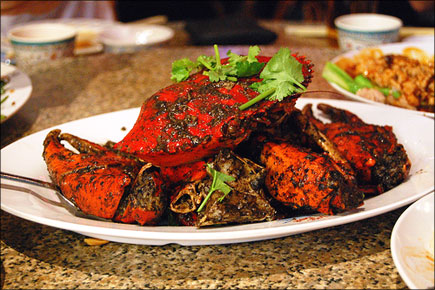 One barrel of wine, it has been said, can work more miracles than a church full of saints. But not if it’s been left out in the sun.
One barrel of wine, it has been said, can work more miracles than a church full of saints. But not if it’s been left out in the sun.
At a recent dinner party at an exclusive Singapore restaurant, the proprietor enthusiastically encouraged a choice from a selection of air-freighted and expensive wines.
But the wine chosen, a 2004 Domaine Leroy Vosne-Romanee burgundy of great repute and equivalent price, was a mess, with the cork breaking through both a wax top and lead capsule and the wine cloudy as a result of a protein haze, as unfiltered, un-fined wholesome pinot noirs are prone to do when mistreated. Temperature extremes had ruined it.
Regrettably this happens all too often. And, with Asian consumers increasingly turning to wine, too often they don’t realize that they are being stuck with bottles that have been mistreated from the time they leave the vineyard to the time they end up on the table. All this adds credence to the widely held theory that Asia is a dumping ground for cheap wine, making it difficult for conscientious suppliers.
Certainly, demand is soaring upwards across a region still largely inexperienced at buying and drinking wine. According to a 2006 study by Vinexpo, wine consumption rose by 150 percent between 2000 and 2005 across Asia. Another study suggests that while North American consumption is slated to grow an average of 5 percent annually, by contrast Asia’s growth will be closer to 10 to 20 percent, with the greatest rise in China, India, Korea, Singapore, Taiwan, the Philippines and Malaysia.
But at tasting panels and many trade tastings and functions over the year around Asia, an alarming number of wines across all price points have been out of condition and clearly associated with poor storage and handling. Contributing to this is the desire to satisfy demand of lower price points against the hindrances of prohibitive duties and taxes and extortionate margins in establishments that do not provide commensurate levels of service and due care.
Certainly consumers need educating. A friend we will call only Robert the Brave (or perhaps Robert the Rash) used to go to Manila and buy entire pallets of fine wine that he could pick up for a song. But there is no telling how much of it he had to simply throw away or use for cooking, because so much of it was bad.
Too often along the supply chain, people tend to forget that wine in fact is a living thing that undergoes a delicate, continuing transformation of chemistry and integration of organisms. It is almost as fragile and spoilable as any other fresh produce and requires specialized handling from production to consumption. Even those who are acquainted with wine often disregard this, believing that wine is resilient in its youth and that the bottle it lives in is sufficiently robust protection. Robert the Brave found this out far too many times. There is a great likelihood in Asia that wine will be “cooked” before it even reaches the docks, unless importers use refrigerated containers for ocean freighting.
The fact is that given too-often unsophisticated consumers, too many exporters, importers, retailers and restaurants know they can get away with serving wines whose quality has simply been broiled away by a tropical sun, a lack of temperature control and collusion between wineries, wine exporters, importers, merchants, retailers and restaurants to turn profits and meet burgeoning demand.
Less expensive wines intended for early consumption are the most mistreated. Yet the reality is that all wine is highly susceptible to temperature fluctuations, light and oxygen. The biggest problem is inadequate storage, with non-air conditioned warehouses irreversibly altering wine’s chemistry and prematurely accelerating the ageing process. Excessive heat can also force the cork upwards, breaking its seal and leading to oxidation. A sure sign of this is wine stains in a vein down the sides of the cork.
Similarly, many wine stores and supermarkets turn their air-conditioning off during non-trading hours, causing temperatures to fluctuate wildly. Another common occurrence in supermarkets is overexposure to high levels of ultraviolet light from fluorescent bulbs. This has a degenerative effect on the organic compounds of wine, causing aroma and flavor to deteriorate.
Even if wine is stored in temperature-controlled warehouses, humidity is often insufficient. While it might seem inconceivable that anywhere in the tropics would be too dry, air-conditioners dehydrate the air and in the same manner as wine left too long in the fridge will dry out the cork, so too can warehouses, shopping malls and supermarkets.
The cost of a reefer is almost three times the amount of a normal dry box container, a deterrent in a highly competitive sector. The temperature inside a container is affected by both radiated and conducted energy. If the outside temperature hits 40C, as it can in Australia during the summer, the inside of a container can go as high as 60C. At 35C, corks will begin to move and it only takes a few hours to affect a wine’s chemistry, with the sustained high temperatures of a 10-day sea journey effectively quadrupling the aging process. Shipping wine in the harsh European winter is equally hazardous. At minus 5C wine will freeze, and at 0C certain wines will throw an unsightly tartrate crystal deposit.
There is a high probability that heat will affect the wine even before it reaches the sea container if temperature-controlled transport doesn’t pick it up from the vineyard. This is often the case in Europe where inland transport is prohibitively expensive, conceivably double the cost of the ocean-freight component. Again, inexpensive wines are the main victims.
All of the issues are easily surmountable. Dedicated wine logistics companies have offices in almost every wine-producing region and major city in the world and they only use vehicles that are temperature-controlled for wine transport and have temperature-controlled warehouses.
Such firms will be equally emphatic about the use of reefer containers, providing the quantities are sufficient (approximately 750 cases). For smaller shipments, consolidated freight services are unavoidable and are rarely offered in refrigerated containers. Most consolidated freight (wine) services use the latest in insulation liners made of energy-reflecting material that turns a dry container into a food-grade container. Coupled with below-deck storage, this substantially reduces sharp temperature fluctuations, and while not ideal, is the most cost-effective and practical.
Nor is air-freighting infallible despite usually being associated to super-premium or collectable and mature wines. There is an illusion that the polystyrene packing is sufficient protection. Most of the conventional airfreight companies that amateurs use have no idea how to treat wine, and within their cumbersome logistics they unintentionally mistreat wine, both in the air and on the ground. Freight forwarders rarely take any measures to compensate for the fact the aircraft cargo hold has no resemblance to the pressurized and temperature controlled passenger environment.
There have been several investigations surrounding these issues, the most conclusive coming from the US Federal Aviation Administration (FAA) which uncovered “temperature ranges in the cargo hold from zero to 104 degrees F (40C) reported in a single flight.” However, this doesn’t begin to give a full picture of the searing temperatures of airport tarmacs and the invariable delays, with temperatures in the cargo hold soaring to boiling point.
The extremes of in-flight temperature are compounded on the ground with near-freezing wine rapidly rising in temperature and exposed to perilous conditions when unloaded, then sitting in non-temperature controlled warehouses awaiting customs clearance, which sometimes can be days, even weeks.
If these detrimental conditions were not enough, final delivery is rarely in temperature-controlled vehicles and can be delayed or even result in the wine being returned to the warehouse if there is no one available to sign for the goods. Consumers would be well advised to use logistics companies associated with handling food and perishables, as they will have dedicated airline food grade cargo containers that are temperature controlled and maintain a certain atmosphere. It may be more expensive, but there is no point going to the trouble of having irreversibly damaged wine sent by airfreight.
Winemakers are increasingly concerned that their product reach the table in optimum condition but are constrained by the minority of reputable merchants whose portfolios are already bursting. Smart microchip technology is beginning to play a role with radio frequency identification (RFID) whereby small tags are attached to cartons that can track shipments and monitor the temperature that the wine has been exposed to. It is only a matter of time before this technology is attached to the wine labels itself and consumers will be able to identify if a wine has been mistreated.
Then there is screwcap technology, which eliminates all the problems associated with cork inadequacies and, moreover, avoids cork taint (mould caused by the chemical TCA or trichloraninsole). Screwcaps don’t prevent the chemistry changes caused by excessive heat or light, but they go a long way toward buffering the effects of rough treatment, primarily invalidating the oxidative problems associated with cork movement, but also combating the uncongenial environments of supermarkets, badly designed stores, restaurant conditions and the expectation that wine will survive vertical floor stacks, display shelves, long sojourns in restaurateurs’ fridges and variables of home consumption.
While New World producers – mainly Australia and New Zealand – have been quick to realize the benefits of screwcaps, European producers, particularly the French, stubbornly cling to tradition or marketability as an excuse to persist with cork.
Reputable merchants with excellent standards and integrity do exist in most Asian cities and are deserving of more support from wine consumers and the hospitality industry, who at the same time should be isolating the irresponsible opportunists.
|
|
Tweet |






3 Comments to Careful with That Wine Bottle | Comments Feed
I admire the valuable tips you offer in your articles and reviews. I will bookmark your blog and have my children check up here often. I am quite sure they will learn lots of new stuff here than anybody else!
good publish, this will likely assist me with some odd stuff i ought to do for college, thanks my pal
BION I’m ipmeressd! Cool post!
The comments are closed.